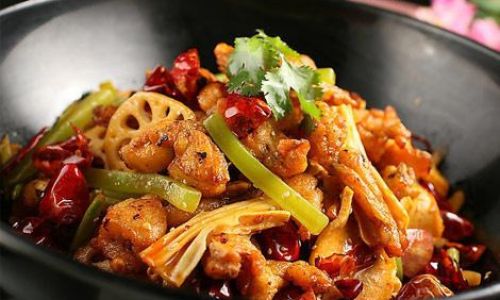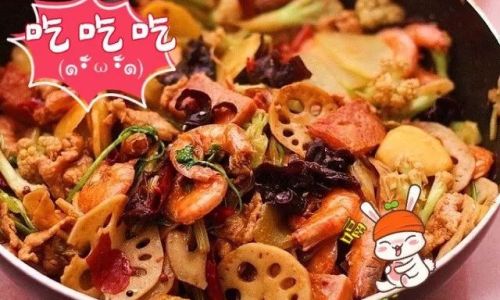Introduction
In the vast culinary landscape of China, there exists a dish that stands out for its bold flavors, vibrant aroma, and the perfect blend of spices. Known as Malaxiangguo (麻辣香锅), this dish translates to “spicy and fragrant hotpot.” Unlike traditional hotpots that are cooked at the table, Malaxiangguo is a pre-cooked, stir-fried medley of vegetables, meats, seafood, and tofu, all bathed in a fiery, fragrant sauce. Its appeal lies in its versatility, allowing for endless combinations of ingredients and the customization of spice levels to suit individual tastes.
In this guide, we will delve into the art of making Malaxiangguo at home, from selecting the right ingredients to mastering the sauce that gives this dish its signature flavor. Whether you’re a seasoned chef or a home cook eager to explore new culinary territories, this recipe promises to deliver an authentic Malaxiangguo experience that will leave your taste buds tingling with delight.

Section 1: Ingredient Selection
The beauty of Malaxiangguo lies in its ability to accommodate a wide variety of ingredients. The key is to choose fresh, high-quality produce and proteins that can stand up to the intense flavors of the sauce. Here’s a comprehensive list of ingredients you’ll need:
Vegetables:
- Potatoes: Sliced into bite-sized pieces and parboiled until slightly tender.
- Carrots: Cut into thin sticks or rounds.
- Bell Peppers: Sliced into strips for a burst of color and sweetness.
- Zucchini: Sliced into half-moons.
- Mushrooms: Quartered or sliced, depending on size.
- Lotus Root: Sliced thinly.
- Baby Corn: Whole or halved.
- Broccoli Florets: For a crunchy texture.
- Green Beans: Trimmed and blanched.
Proteins and Seafood:
- Chicken Breast: Cubed and marinated with soy sauce, ginger, and garlic.
- Shrimp: Peeled, deveined, and tails left on for presentation.
- Squid: Cut into rings or tubes.
- Pork Belly: Sliced thinly and cooked until crispy.
- Tofu: Cubed and lightly fried.
Aromatics and Spices:
- Garlic: Finely chopped.
- Ginger: Sliced thinly or grated.
- Scallions: Cut into long segments.
- Chili Peppers: Fresh red or green chilies, sliced, and dried red chilies for extra heat.
- Sichuan Peppercorns: Toasted and ground for that unique numbing sensation.
- Star Anise, Cloves, and Cinnamon Stick: For depth of flavor.
- Flower Pepper (optional): For an additional layer of aroma.
Sauce Ingredients:
- Vegetable Oil: For frying.
- Doubanjiang (Chili Bean Paste): The backbone of the sauce.
- Hoisin Sauce: For sweetness.
- Soy Sauce: Light and dark for color and flavor.
- Sesame Oil: For richness.
- Oyster Sauce: For added umami.
- Sugar: To balance the heat.
- Chicken or Vegetable Broth: To thin out the sauce.
- Cornstarch Slurry: To thicken the sauce if needed.
Section 2: Preparing the Ingredients
Before diving into the cooking process, it’s crucial to prepare all your ingredients meticulously. This ensures that the cooking time is minimized and the flavors are evenly distributed.
-
Vegetables: Parboil the potatoes and any other vegetables that require it until they are just tender. Drain and set aside. Blanch the green beans until crisp-tender.
-
Proteins and Seafood: Marinate the chicken with soy sauce, ginger, and garlic for at least 30 minutes. Peel and prepare the shrimp, squid, and other seafood. Cook the pork belly slices until crispy and set aside. Lightly fry the tofu cubes until golden brown.
-
Aromatics and Spices: Prepare the garlic, ginger, and scallions. Toast the Sichuan peppercorns until fragrant and then grind them. Set aside the dried red chilies for later use.
Section 3: Making the Sauce
The sauce is the heart of Malaxiangguo, and its preparation requires precision and attention to detail.
-
Heat the Oil: In a large wok or heavy-bottomed pan, heat a generous amount of vegetable oil over medium-high heat.
-
Fry the Aromatics: Add the chopped garlic, grated ginger, and sliced fresh chilies. Stir-fry until fragrant, being careful not to burn the garlic.
-
Add the Spices: Incorporate the toasted and ground Sichuan peppercorns, star anise, cloves, and cinnamon stick. Let the spices toast slightly in the oil to release their flavors.

-
Incorporate the Sauces: Add the doubanjiang and stir-fry until the oil separates and the sauce is fragrant. Follow with hoisin sauce, soy sauce (both light and dark), sesame oil, and oyster sauce. Stir well to combine.
-
Adjust the Seasoning: Taste the sauce and adjust with sugar to balance the heat. If the sauce is too thick, add a little chicken or vegetable broth to reach your desired consistency.
Section 4: Cooking the Ingredients
Now that the sauce is ready, it’s time to cook the ingredients. This step requires careful timing to ensure that each component retains its texture and flavor.
-
Fry the Vegetables: In batches, add the prepared vegetables to the hot oil in the wok. Stir-fry until they are lightly browned and slightly crispy. Remove and set aside.
-
Cook the Proteins and Seafood: In the same wok, add a bit more oil if needed and stir-fry the marinated chicken until golden brown. Remove and set aside. Do the same with the shrimp, squid, and any other seafood, ensuring they are cooked through but not overdone.
-
Combine Everything: Return all the cooked ingredients to the wok, pouring the sauce over them. Stir gently to coat each piece evenly with the sauce. Cook for a few minutes until everything is heated through and well combined.
Section 5: Finishing Touches
The final touches are what elevate Malaxiangguo from good to great.
-
Thickening the Sauce (Optional): If the sauce is too thin, make a cornstarch slurry by mixing a small amount of cornstarch with water. Stir it into the wok and cook for another minute until the sauce thickens to your liking.
-
Garnish: Sprinkle with ground Sichuan peppercorns, sliced scallions, and additional fresh chilies for garnish. Serve immediately while hot.
Section 6: Serving and Enjoying
Malaxiangguo is best enjoyed hot, with a steaming bowl of rice on the side to soak up the delicious sauce. It’s also wonderful paired with cold beverages to counteract the heat. Don’t forget to adjust the spice levels to your preference – Malaxiangguo is as bold or as mild as you make it.
Conclusion
Making Malaxiangguo at home is a rewarding culinary adventure that brings the vibrant flavors of Chinese street food into your kitchen. With its blend of spicy, savory, and slightly sweet notes, this dish is sure to become a favorite among family and friends. By following this guide, you’ll be able to create an authentic Malaxiangguo experience that captures the essence of this beloved Chinese dish. Happy cooking!





0 comments